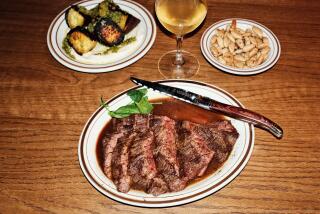The zen of maximum flavor
- Share via
Etched with char marks and fitted with iron pots sunk into their centers, four 500-pound kamados, urn-shaped ceramic cookers, greet you as you enter Torafuku in West Los Angeles.
At this restaurant, the specialty is kamado-cooked rice, and thanks to these leviathans, each perfectly delineated, silky grain has a toasty flavor, a result of steaming and baking inside the kamado’s thick walls.
But man doesn’t live on rice alone, as the folks behind Torafuku clearly know. The prime steak grilling in the restaurant’s open kitchen is grass-fed and organic. Sizzling next to it is free-range chicken that comes from the same farm as the eggs with richly flavored, orangy-yellow yolks that garnish several dishes. Also on the grill are huge, fresh Santa Barbara prawns. The pork on the menu is Kurobuta, prized for its succulence. And all the restaurant’s sakes are junmai, naturally brewed without added brewer’s alcohol.
Torafuku aims to replicate the close-to-the-earth, country-style meals you might experience in a ryokan or Japanese country inn. Almost everything is cooked in the simplest way, coaxing maximum flavor from the ingredients.
Chef Tetsuya Harikawa, who has cooked in L.A. restaurants for almost a decade, has a reputation in the Japanese expat community for his purist approach. His philosophy is nothing new in Japan, where connoisseurs drive hundreds of miles to savor just-picked matsutake mushrooms gathered from a forest floor. It is just such food devotees who frequent the Tokyo branches of Torafuku, whose overseas managers sought out Harikawa to open near Westside Pavilion. The L.A. restaurant attracts a sophisticated, transpacific clientele: guys in Eminem-ish attire and women in edgy East-West fashions that look straight out of Tokyo’s trendy Harajuku district.
Torafuku’s dining rooms display an au courant balance of traditional Japanese and Western design, with comfortable high-backed upholstered chairs and cloth-napped tables. A semiprivate VIP area faces a small garden, and there’s a dining bar facing the kitchen action.
A menu of moderately priced bento lunches (two include Kurobuta pork) is an inexpensive way to try a kamado rice meal.
Torafuku’s long dinner menu is organized into various okazu, small dishes to accompany rice; each has nearly equal weight in a meal. Okazu include sashimi, grilled foods, Japanese delicacies, soups and a la carte items.
Kamado rice may be ordered a la carte or in a “set” with organic miso soup, a small appetizer and house demi-cured pickles. Combination dinners (the equivalent of tasting menus) include the rice set, three appetizers, a larger course and dessert. These meals are grand affairs, but they leave less opportunity to experiment with okazu.
The first appetizer is two sorts of sashimi alongside a thimble-size mound of freshly grated wasabi. The second is a small cedar tub of homemade nigari tofu, prepared without a commercial coagulant. Arriving warm, it has the texture of custard. Finally, there’s a little bowl of braised winter root vegetables, showered with freshly roasted sesame seeds.
Next, you select the main dish from five offered. We chose the multi-item, deep-fried cutlet sampler course. It includes a plump, juicy oyster, thick Kurobuta pork tenderloin and one of those humongous fresh Santa Barbara prawns, all enrobed in seemingly weightless shaggy panko crumbs.
Vanilla ice cream may seem an unimaginative desert, but swirled with homemade bittersweet caramel sauce and sprinkled with toasted soy powder, it’s an East-West marvel.
A la carte sashimi is offered in three styles: cut as paper-thin carpaccio, traditionally sliced, or tatake-style (finely diced). One unusual sashimi-tofu dish involves freshly harvested Santa Barbara uni over a plate of yuba. This thin film, lifted from the surface of heated soy milk and rolled up like a miniature bolt of satin, tastes clean and sweet.
I highly recommend the a la carte rice dishes, or gohan mono. Tou-ban-yaki, an extravagant arrangement of cured salmon and marinated vegetables on rice, topped with a poached egg, is presented on a sizzling plate and mixed at the table. The soft grains alternate with crisped bits and rich garnishes. Another version, jyako tou-ban-yaki, involves minuscule dried anchovies in place of the salmon.
Also a la carte, Manila clams simmered with garlic stems yield an amazing subtle broth with universal appeal. But one section of the menu warns “not for the faint of heart” and lists such traditional rice condiments as shiokara (preserved fermented octopus) and grilled miso with buckwheat seeds.
Chef Harikawa says he sees his American customers’ preference for free-range meats, artisanal breads and cheeses as signs that they’re ready for Torafuku’s efforts -- even the less familiar offerings.
An old Japanese saying holds that the pleasant experience of eating something you’ve not tasted before will lengthen your life by 75 days. I’m figuring that discovering Torafuku will add quite a few years to mine.
*
Torafuku
Location: 10914 Pico Blvd., West Los Angeles, (310) 470-0014
Price: Appetizers and okazu (served family style), $5 to $20; bento lunches, $8.50 to $12; set dinners, $36 to $55.
Best dishes: Tou-ban-yaki rice; homemade tofu; atari clams with garlic stems; Kurobuta tonkatsu, salmon carpaccio.
Details: Open for lunch, noon to 2:30 p.m. Monday through Saturday. Open for dinner 6 to 10 p.m. Monday through Thursday; 6 to 10:30 p.m. Friday and Saturday; 5 to 10 p.m. Sunday. Beer, wine and sake. Valet parking, $4.50. All major credit cards.
More to Read
Eat your way across L.A.
Get our weekly Tasting Notes newsletter for reviews, news and more.
You may occasionally receive promotional content from the Los Angeles Times.







